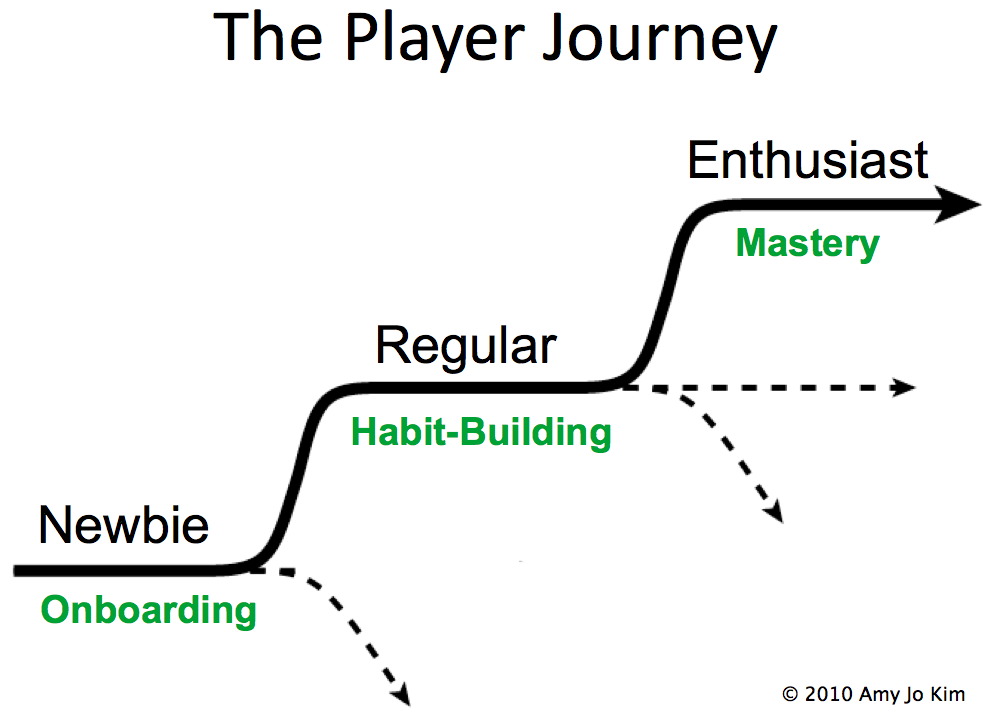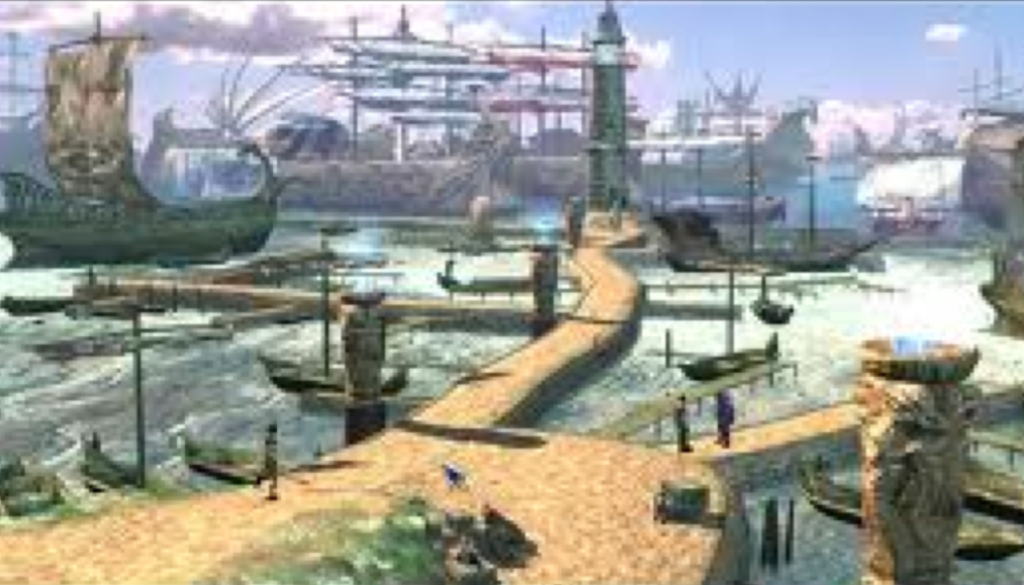The Player’s Journey: Designing Over Time
I’ve been enjoying this lively Branch discussion around points, levels, and leaderboards in social software – and even more this thoughtful response by Tom Tunguz of Redpoint, who added a much-needed “over time” perspective to the discussion.
When I engage with Web developers building digital services, the most common mistake they make is thinking about their social stats and UI as static. A key lesson I’ve absorbed from years of game design is to Design Your Player’s Journey Over Time. Great games are compelling because the player’s experience and expertise changes over time in meaningful ways. Games dole out just the right amount of challenge and learning to keep the player engaged and on the edge of her ability. In short, games are compelling because they’re pleasurable learning engines – they offer up skills to master, and reward you with greater challenges & opportunities. (Raph Koster write eloquently about this in A Theory of Fun for Game Design, great background reading)
 Progress metrics (points, badges, levels, leaderboards, reputation systems) are icing on this learning/mastery cake: very helpful to gauge where you stand, and how far you’ve come, but meaningless as a stand-alone system without the learning engine to keep you truly engaged.
Progress metrics (points, badges, levels, leaderboards, reputation systems) are icing on this learning/mastery cake: very helpful to gauge where you stand, and how far you’ve come, but meaningless as a stand-alone system without the learning engine to keep you truly engaged.
Design Over Time thinking also can help you grow a successful community. The features that propel a digital community will CHANGE as the community scales from 500 to 5000 to 50,000. The story of Digg’s leaderboard (referenced in this Branch) – which worked great when Digg was up-and-coming, then backfired when Digg got big and well-known – is an object lesson in how effective game design must scale along with community growth.
So when you’re creating your next social app, website or game, focus first on what your community needs to kickstart social – but pay close to attention to what’s working over time, and be prepared to change and evolve your social and gaming UI as your community grows. Don’t be afraid to remove a stuff that’s not working! It doesn’t mean you’ve failed – on the contrary, it’s a natural part of growing a strong community.
What’s your experience? Have you seen these dynamics in action? Want to learn more about this topic? I’d love to hear from you in the comments.

Designing Sustained Engagement: 3 Questions to get you started | Amy Jo Kim
October 3, 2012 @ 3:44 pm
[…] 2) How will you define, measure, visualize and reward Progress Over Time? […]
Links for October 24, 2012 | Andrzej's Links
October 24, 2012 @ 4:46 pm
[…] The Player’s Journey: Designing Over Time | Amy Jo Kim […]
Relatedness: The Often Ignored Glue of Gamification | Andrzej's Blog
November 26, 2012 @ 11:00 am
[…] let’s break this down a little. Amy Jo Kim in her blog wrote about player journey a while back. Amy used the following image to describe the basic […]
Relatedness: The Often Ignored Glue of Gamification « DataTel Technology Group
November 28, 2012 @ 5:17 am
[…] let’s break this down a little. Amy Jo Kim in her blog wrote about player journey a while back. Amy used the following image to describe the basic […]
Flow, Player Journey and Employee Satisfaction | Andrzej's Blog
November 30, 2012 @ 4:00 pm
[…] Jo Kim wrote about the idea of The Player Journey. “Great games are compelling because the player’s experience and expertise changes over time in […]
December 19, 2012 @ 9:42 am
I wanted to thank you for this good read!! I certainly enjoyed every bit of it.
I have got you saved as a favorite to check out new things
you post…
February 17, 2013 @ 11:53 am
It’s actually a nice and useful piece of info. I am happy that you shared this helpful information with us. Please stay us up to date like this. Thank you for sharing.
April 19, 2013 @ 7:52 pm
You made some really good points there. I checked on the net to learn more about the issue
and found most people will go along with your views on this web site.
May 2, 2013 @ 6:42 pm
Simply wish to say your article is as amazing. The clarity in your post is just excellent and i can assume you are an
expert on this subject. Fine with your permission let me to grab your RSS
feed to keep up to date with forthcoming post. Thanks a million and
please continue the enjoyable work.
May 3, 2013 @ 6:47 am
It’s hard to find knowledgeable people on this topic, however, you sound like you know what you’re talking about!
Thanks
May 22, 2013 @ 10:48 am
An interesting discussion is definitely worth comment.
There’s no doubt that that you need to publish more about this issue, it may not be a taboo matter but typically folks don’t talk about these subjects.
To the next! Best wishes!!
June 7, 2013 @ 4:31 pm
It’s a shame you don’t have a donate button! I’d without a doubt donate to this superb blog! I guess for now i’ll settle for book-marking and adding your RSS feed to my Google account.
I look forward to fresh updates and will talk about this website
with my Facebook group. Chat soon!
Greetings from Florida! I’m bored at work so I decided to browse your site on my iphone during lunch break. I enjoy the information you present here and can’t wait to take a look when I
get home. I’m amazed at how quick your blog loaded on my phone .. I’m not even using WIFI, just 3G .
. Anyhow, awesome blog!
June 22, 2013 @ 8:14 pm
What a data of un-ambiguity and preserveness of valuable knowledge regarding unpredicted emotions.
July 10, 2013 @ 1:30 pm
Hello! Can you mind if I share your blog with my twitter group?
July 11, 2013 @ 6:11 pm
I am really impressed with your writing skills as well as with the layout on your
weblog. Is this a paid theme or did you modify it yourself?
Anyway keep up the excellent quality writing, it’s rare to see a nice blog like this one these days.
July 16, 2013 @ 4:08 am
fantastic publish, very informative. I wonder why the opposite experts
of this sector do not realize this. You should continue your writing.
I am sure, you’ve a great readers’ base already!
qpiter | Gamification neigt dazu, sich um Belohnungen zu drehen
July 22, 2013 @ 8:03 pm
[…] Überraschungen auszudenken gehört zum Handwerk des Game Designers. Besonders in Hinblick auf die Reise des Spielers ist das […]
July 23, 2013 @ 1:14 pm
If you want a Premium Minecraft Account check out this generator.
With it you can generate a unique Minecraft Premium Account which no one else
has! You can Download the Free Premium Minecraft Account Generator http://www.
minecraftfreakz.tk
I’m very happy to discover this site. I wanted to thank you for ones time for this wonderful read!! I definitely enjoyed every bit of it and i also have you book marked to look at new information on your site.
Etapy podróży użytkownika w gamifikacji, grywalizacji
September 24, 2013 @ 3:43 pm
[…] [i] The Player’s Journey: Designing Over Time, http://amyjokim.com/2012/09/14/the-players-journey-designing-over-time/ […]
The Developer’s Journey: LeanUX meets the Customer Lifecycle | Amy Jo Kim
October 20, 2013 @ 5:30 pm
[…] The X (horizontal) axis shows the key stages of the Player’s Journey: Onboarding, Habit-Building, Mastery. […]
Links for December 10, 2013 | Andrzej's Links
December 10, 2013 @ 4:36 pm
[…] The Player’s Journey: Designing Over Time | Amy Jo Kim […]
Customer Journey Maps for Games | Gbanga
February 12, 2014 @ 4:14 pm
[…] concept of Customer Journey Maps, Player Journey Maps or «Player’s Journey» (as Amy Jo Kim calls it) is very flexible and can be applied very creatively without being to strict about the […]
February 15, 2014 @ 12:16 am
Its like you learn my mind! You appear to grasp so much approximately this, like you wrote the
e-book in it or something. I believe that you just could do with a few p.c.
to force the message home a bit, however other than that, that
is fantastic blog. A fantastic read. I’ll certainly be
back.
February 15, 2014 @ 2:37 pm
Thank you for sharing your info. I truly appreciate your efforts and I
will be waiting for your further write ups thank you once
again.
February 16, 2014 @ 1:20 am
Great article. I will be going through a few of these issues as well..
February 19, 2014 @ 11:46 pm
Although internet websites we backlink to beneath are considerably not connected to ours, we really feel they’re actually really worth a go via, so have a look.
February 20, 2014 @ 11:47 am
Cool blog! Is your theme custom made or did you download it
from somewhere? A theme like yours with a few
simple tweeks would really make my blog shine. Please
let me know where you got your theme. Thanks a lot
February 21, 2014 @ 3:50 am
I just want to mention I am very new to blogging and certainly enjoyed your blog site. Very likely I’m want to bookmark your blog . You absolutely have good well written articles. Kudos for revealing your website page.
February 21, 2014 @ 4:42 am
Hi there all, here every one is sharing these knowledge,
thus it’s nice to read this blog, and I used to visit this weblog everyday.
February 21, 2014 @ 5:32 am
I know this website provides quality based articles or reviews and other
data, is there any other website which gives such stuff in
quality?
February 24, 2014 @ 8:01 pm
Very nice post. I just stumbled upon your blog and wanted
to say that I’ve really enjoyed browsing your blog posts. After all I will be subscribing to your rss feed and I hope you write again very soon!
The User Hero's Journey - Gamification: Andrzejs Blog
March 18, 2014 @ 12:13 pm
[…] chosen to use just nine steps of these steps. Also, for added enjoyment -I have merged it with Amy Jo Kim’s Player […]
April 9, 2014 @ 1:07 am
You made some really good points there. I checked on the net to learn more about the issue
and found most people will go along with your views on this web site.
April 28, 2014 @ 3:39 pm
The Player’s Journey: Designing Over Time
Customer Journey Maps for Games — Gbanga, creator of mixed-reality games
April 29, 2014 @ 2:00 pm
[…] concept of Customer Journey Maps, Player Journey Maps or «Player’s Journey» (as Amy Jo Kim calls it) is very flexible and can be applied very creatively without being to strict about the […]
kamper wynajem
October 6, 2014 @ 4:58 am
kamper wynajem
The Players Journey: Designing Over Time
Design For Engagement | Lord Sillion - Holistic Thinking Ninja
May 12, 2015 @ 4:21 pm
[…] about design an activity with life-cykle aspect in mind. Start with Onboarding for the Newbie like Amy Jo Kim says. Then makes sure there are different challenges with increasing difficulty so that a […]
All About Gamification: Engage the WORL&D! | Rabbitoreg (Zsolt Olah)
August 25, 2016 @ 6:59 pm
[…] first, but after a while, you may alienate them by treating them still as rookies. Kevin Werbach,Amy Jo Kim and Yu-kai Chou have their own versions the multi-phased journey over time: Exploration, […]